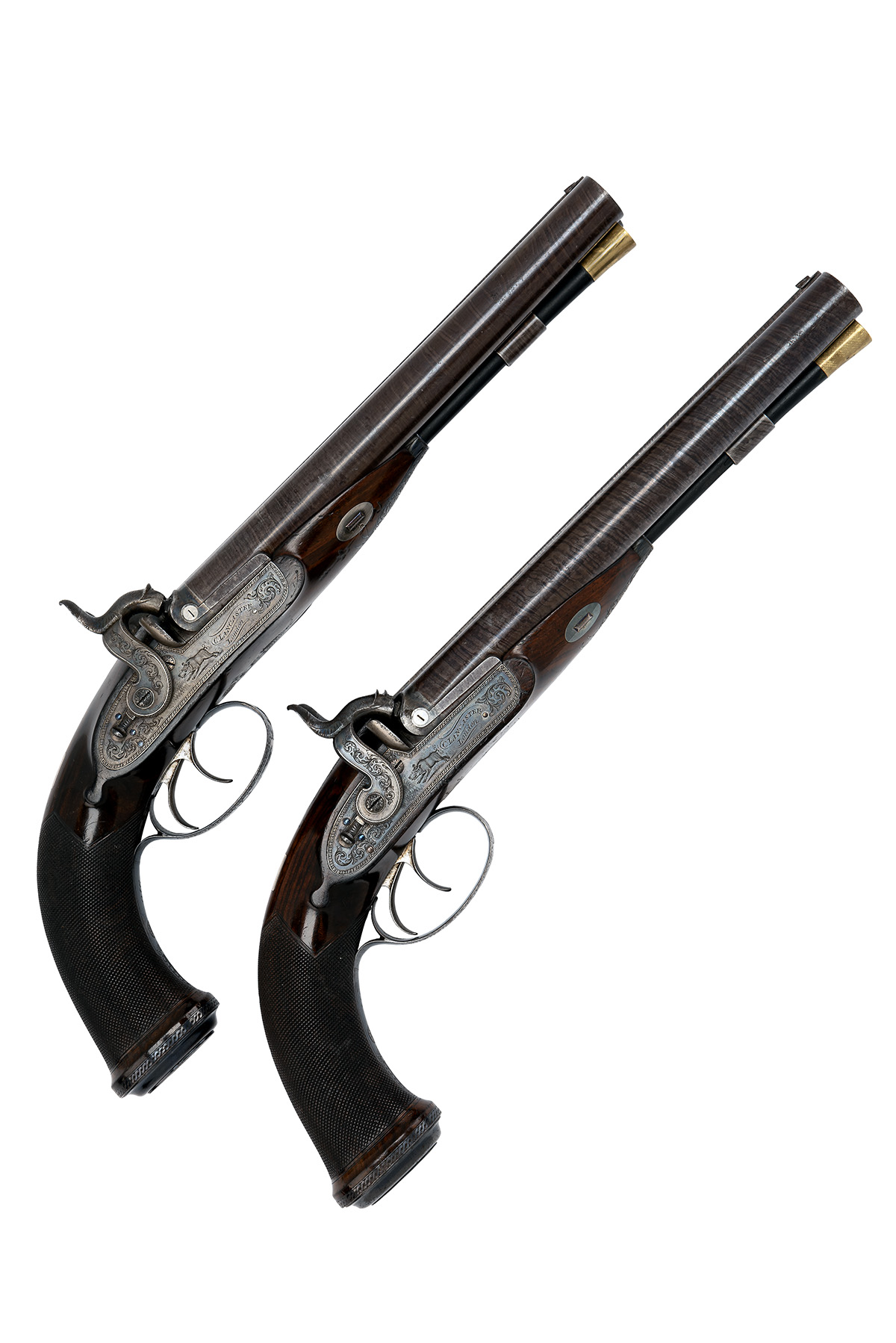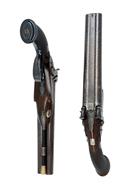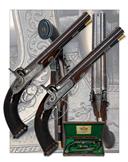Product Details
A RARE CASED PAIR OF CHARLES LANCASTER 16-BORE PERCUSSION DOUBLE-BARRELLED RIFLED HOWDAH PISTOLS, serial no. 910 / 911,
circa 1840, with browned side by side 9in. barrels signed on the top-flats 'CHARLES LANCASTER 151 NEW BOND ST. LONDON', all barrels also bearing Irish registration numbers 'WA428' or 'WA429' respectively, moulded colour-hardened breech-blocks with platinum vents, the tops inlet with a platinum line and the rib-endS engraved with a lioness mask, dove-tailed bead fore-sights, standing notch rear-sights to the fronts of the colour hardened fully engraved top-tangs, colour hardened border, scroll and gamescene engraved bar-action locks with sliding safes behind the dolphin-headed hammers, the bars signed 'C. LANCASTER, LONDON' between scrolled lines, walnut half-stocks with finely chequered swept butts, each fitted with an engraved and moulded off-set blued iron butt-cap, guarded plain triggers, rectangular white metal clipped corner escutcheons to the wrists and oval escutcheons to the blued barrel keys, engraved ramrod throats with plain thimbles and brass tipped ebony ramrods, both pistols in a good state of preservation with much original finish and colour intact and complete with their makers brass cornered mahogany case (lock escutcheon absent), replacement trade-label inside lid, the tray relined and compartmented in green baize and complete with a leather covered flask, mould, loading rod and sundry other accessories
Provenance: The Lancaster register states 'Made for the Marques of Watteford (sic). 16 Bore, 9in. Barrels 5/8in. chambers 1850'. The date is probably incorrect, as pistol serial number 500 is known to be 1833 and number 3290 is dated 1860. The presence of 1843 census stamps would suggest these are nearer 1840.
Henry de La Poer Beresford, 3rd Marquess of Waterford (1811 - 1859) was the second son of the 2nd Marquess, but became Earl of Tyrone and heir to the marquessate at age 13 following the death of his elder brother. Just two years later, following the death of his father, Henry inherited the title Marquess of Waterford. The following year his mother died and so the young Marquess was left without parental guidance, handsome, and incredibly wealthy.
Waterford's 20's were littered with tales of wild exploits and debauchery. In 1835 he sailed to New York with his entourage, and after a night of drinking they embarked on a drunken spree on the way back to their lodgings smashing windows, lampposts and they "attacked, unmercifully beat, and nearly denuded, an inoffensive passer-by". A city watchman, having never been told to spare nobility, attempted to arrest the party, at which the Noble group took offence and beat the watchman. Eventually more of the watch joined the fight, overpowered the drunken cohort and arrested the lot. They were bailed out the next day by the British consul.
A similar escapade occurred a few years later in Bergen, Norway, but the Bergen watch were made of sterner stuff and the young Marquess took a blow to the head from a watchman's morning star truncheon which nearly ended his life. An interview with the watchman in question revealed that "… he came upon a couple. The woman was wearing a man's hat, the gentleman was hatless. The gentleman took offense to the watchman's question and picked up a stone to wave it at him. The watchman, wanting to keep from being hit with a stone, tried to smack the gentleman's arm with a club. The ill-timed ducking happened and he clocked him on the head." The matter was resolved in court, Waterford was absolved of wrongdoing and the watchman (a father of four and military veteran) after agreeing to pay expenses was not prosecuted further.
In 1836 Waterford embarked on a big game hunting trip to Tunis, he returned to his country seat, Curraghmore, with three lion cubs, which he kept in his bedroom and trained to accompany him around his estate.
In 1837 Waterford and a group of friends attended the Croxton Park races, after which they descended on Melton Mowbray, where a toll-keeper somewhat unwisely demanded the group pay the toll. They barricaded the toll-keeper in his lodge, found some buckets of red paint and proceeded to daub the lodge, tollgate, and everything else in their path with red paint. Apparently, the group walked to a nearby public house called the Old White Swan. Waterford was hoisted onto the shoulders of his friends and painted the swan red. Whilst lacking credibility, this great tale is thought by some to have given rise to the phrase 'painting the town red'.
In 1842 Waterford married Louisa Stuart, daughter of the 1st Baron Stuart de Rothesay, in Whitehall. The wedding was the place to be and the police had to keep order around the entrance of the church. They spent a week honeymooning in Surrey before returning to Curraghmore. By all accounts Waterford was a changed man, and well behaved until his death following a fall from his horse in 1859.
There are also suggestions that the Marquis of Waterford was 'Spring Heeled Jack', a notorious urban legend of Victorian-era London. Spring Heeled Jack was described by people who claimed to have seen him as having a terrifying and frightful appearance, with diabolical physiognomy, clawed hands, and eyes that "resembled red balls of fire". One report claimed that, beneath a black cloak, he wore a helmet and a tight-fitting white garment like an oilskin. Many stories also mention a "Devil-like" aspect. Others said he was tall and thin, with the appearance of a gentleman. Several reports mention that he could breathe out blue and white flames and that he wore sharp metallic claws at his fingertips. The London attacks became rare after the 1840's which coincide with Waterford settling down. However, as that character's acts continued after his death in 1859, Waterford cannot be given sole responsibility.
Please click HERE to view Terms & Conditions. Please note all Lots are listed in accordance with UK Law, for overseas buyers, please ensure you are familiar with your relevant local firearms and customs regulations before bidding.
Estimate £5,000-7,000







